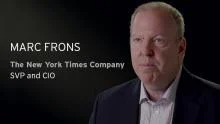Marc Frons, senior vice president and CIO of the New York Times Company, explains how technology can help the Times thrive in the digital age.
Click on the video or read the transcript below.

"I'm very passionate about telling stories, using technology for the future of journalism, for the present of journalism and really finding new ways for my industry, the newspaper industry, the New York Times, to thrive in the digital age."
The Enterprisers Project (TEP): How are you building a culture of innovation?
"The interesting thing is having a career in media. You're working for companies that are really not technology companies. Content is king. The journalists are really the center of the universe. Technology was really just purely a service part of the company.
What I realized is that technology has to be strategic and has to be at the center of what we do because technology and journalism are really intertwined. So for me it was about instilling a culture of innovation and instilling an engineering culture at the Times. So we don't treat our engineers and our technologists as mere order-takers, we consider them peers with the other creative people at the company and the business folks at the company.
So we have instituted technology contests, hack days, the kinds of things that you would see in a technology company than in a traditional media company."
TEP: How do you break down the barriers between the CIO and the C-Suite?
"I think it's both formal and informal. So I have one-on-ones with every member of the executive committee, including my boss, the CEO, as often as I can. But the informal relationships are just as important if not more important.
It's not just about me, it's about my CTO and my Chief Security Officer and my Chief Data Officer, all really presenting a united front to my C-Suite colleagues and really explaining the strategic value of IT, and also coming to them with specific initiatives.
So, a concrete example, when I became CIO, our data was very siloed across the company, mostly because we had different technology groups. We had a digital technology group and we had a print and corporate technology group and everybody had their own little silos.
And I said, listen, we really need to have one data facility across the company because data is going to be so important to our business. So we created, what we called then, The Business Intelligence Group, to be renamed as our Data Science and Engineering Group, to really unlock the power of data across the company. And then furthering that, saying, hey, we want to democratize data. And we are going to start a project where we are going to make a browser based dashboard of all the metrics that are really important to you as a C-Suite executive, you as a product manager, you as a marketing manager, on a daily, if not hourly basis."
ALSO READ
- CIOs: make your big data actionable from your CEO to your customer service rep
- When approaching big data, don't put a Ferrari engine in a Volkswagen body
- 2015: The year enterprises move past big data experimentation




